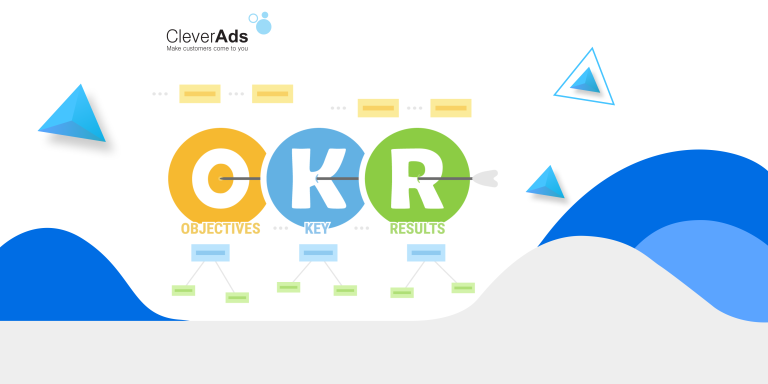What are Marketing Goals? Marketing Goal-Setting Model

Today, businesses show investment in using many different marketing methods for their products and services. In addition to taking advantage of many resources for Marketing activities, businesses also set clear Marketing goals for each of their tasks and plans.
So what is a Marketing goal? How do you set it up effectively? Let’s find out with CleverAds in the article below!
1. What are Marketing goals?
Marketing goals are specific, measurable goals that help businesses meet broader business goals and better define the steps in their plans and strategies.
Any campaign launched without a clear strategic goal is likely to be wasted resources and fail. Without goals, businesses will not know how to measure the value they spend.
Examples of Marketing goals:
- Build brand awareness
- Search and approach potential customers
- Establish thought leadership
- Allocate marketing activities to generate revenue
- Increase brand engagement
Read more:
2. Why set Marketing goals?
Setting goals will help businesses orient their strategic plan in the right way. Achieving the objectives means that the success and effectiveness of the campaign have been recognized and created a definite influence in the market.
Every business has products/services that need to be planned and implemented in different forms of advertising. However, setting the right goals for each product is always a big challenge, requiring marketers to have the knowledge and skills to set effective goals.
In theory, there will be suggested models for businesses to set marketing goals with filled internal factors.
In addition, setting goals in the right direction also brings many advantages to businesses:
- The enterprise can determine the development direction and existing capacity.
- Increase the ability to respond to market changes.
- Clearly show the responsibilities of each department in the business.
- The basis for checking and evaluating whether the activities are being carried out under the plan and the level of achievement with the set targets.
Therefore, setting and practicing goals, and achieving marketing goals is the best path to the success of every business.
Read more:
3. Effective Marketing Goal-Setting Models
3.1 SMART model
Marketing objectives implemented according to the SMART model are effective by the following factors:

Specific – Specifically:
Specific metrics should be used in the marketing objectives of the business. Don’t just set a Marketing goal to increase sales, but set a specific goal of how much you want to increase sales – by percentage or amount.
Measurable – Can be measured:
Goals should be measurable, and you should outline how you will measure success. Your goal might be to increase brand awareness, but it should include how you’ll measure it, for example, measuring an increase in organic brand search or social media following.
Achievable – Attainable:
It is possible to want to increase sales many times, but one must consider whether that goal is achievable or not. Make sure the benchmarks you set are reasonable and achievable and outline the steps needed to reach them.
Relevant
One of the main downsides of goals is the outline of the destination, but the reality is that not every single hit of that standard will have an impact on the entire marketing strategy. Objectives must align with the goals, strategies, and plans of the business.
Timed – Based on time:
Finally, the goals should include the right time frame for achieving the specific criteria. Most Marketing goals are based on quarterly or annual financials, but that can vary depending on the goal and the amount of work required to meet the standard.
Read more:
3.2 Model CLEAR
CLEAR is a goal-setting model that combines logic and emotion. These goals are clear and focused on engaging customers emotionally in the campaign they do.

- Collaborative – create affiliate goals to drive purchase motivation
- Limited – set goals that have a specific scope and a timeline for implementation
- Emotional – choose to describe many emotions, make customers receive positive energy
- Appreciable – measure by breaking down big goals into actionable steps and measuring it
- Refinable – ready to tweak, and modify goals to improvise with all the latest situations
3.3 Set marketing goals according to OKR
Objectives and key results (OKR) – a management framework for setting business, team, and employee goals.
At each level, there will be 3 to 5 goals defined and closely linked to the main outcome. Goals are typically set quarterly and reviewed on a monthly or weekly basis as follows:

- Objectives: Identify and set 3 to 5 qualitative, time-bound, and achievable goals
- Key Result: Quantify each goal by setting 3 to 5 results to measure
With 3 ways to set up Marketing goals according to SMART, CLEAR, and OKR models, each concept from the models includes many similar and different factors that will fit each goal that each business needs.
With the existing optimal models, marketers should refer to and apply them to set goals for businesses. However, it is necessary to observe the actual situation, monitor product sales, and respond to customers to build Marketing goals that meet the requirements of the campaign and the defined target audience to get results. the best.
Read more:
4. Conclusion
Through the article, readers understand Marketing goals and approach goal-setting models in the right direction, bringing efficiency and achieving the criteria set out in the business’s strategy. How to create a Marketing goal and implementing it is always an important step to help businesses promote their strengths and competitive advantages in the market.




